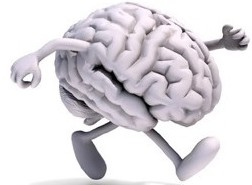by
Stepy —
March 16, 2019
- Out of all the signs of aging, the one people seem to fear the most is the loss of memory and mental sharpness. As brain expert Daniel Amen M.D. says, “brain health is enhanced by good diet as well as physical, mental, and social activities.”
- We lose gray and white matter in the brain as we age, which decreases mental sharpness. Promoting connections between the brain’s nerve cells can keep you sharp.
- Grey brain matter is in charge of processing information, and cognitive tasks and white matter acts as a communication center between different areas of the brain. Studies show that exercise, social, and mental activities are the best ways to save the white and grey matter in your brain and keep it healthy.
- Omega-3 DHA is the most abundant fat in the brain tissues. There is also mounting evidence that DHA protects gray and white matter and promotes healthy brain networks.
- A study from Scotland suggests that physical activity may be especially important for preserving the brain’s white matter and keeping it healthy.
- A team at the University of Edinburgh set out to see which factors known to affect the health and volume of white matter might work best to maintain it.
-
- The results demonstrated that the people who reported the most physical activity had healthier white matter.
- Dr Alan Gow of the University of Edinburgh’s Centre for Cognitive Ageing and Cognitive Epidemiology who led the research, said: “Our results suggest that to maintain brain health, physical activity may be more beneficial than choosing more sedentary activities. We are excited by the next stages of this research as we seek to understand more about what might underlie the effect, but in the meantime, increasing physical activity – even a short walk each day – can only be encouraged.
- Try to follow these steps to help maintain your sharpness and memory:
- 20+ minutes of exercise per day
- A healthy diet: Avoid processed foods, refined sugars and sodas
- Stay socially active
- Read a good book
- Play games to stimulate your brain
- Laugh often
- Note: None of the information in our website is intended to diagnose, treat, cure or prevent any illness or disease. The content on our website is for educational purposes only.
- REFERENCES:
- Godin O, Maillard P, Crivello F, Alpérovitch A, Mazoyer B, Tzourio C, Dufouil C. Association of white-matter lesions with brain atrophy markers: the three-city Dijon MRI study. Cerebrovasc Dis. 2009;28(2):177-84. doi: 10.1159/000226117. Epub 2009 Jun 25.
- Gow AJ, Bastin ME, Muñoz Maniega S, Valdés Hernández MC, Morris Z, Murray C, Royle NA, Starr JM, Deary IJ, Wardlaw JM. Neuroprotective lifestyles and the aging brain: Activity, atrophy, and white matter integrity. Neurology. 2012 Oct 23;79(17):1802-1808.
- Saczynski JS, Jonsdottir MK, Sigurdsson S, Eiriksdottir G, Jonsson PV, Garcia ME, Kjartansson O, van Buchem MA, Gudnason V, Launer LJ. White matter lesions and cognitive performance: the role of cognitively complex leisure activity. J Gerontol A Biol Sci Med Sci. 2008 Aug;63(8):848-54.
-



















Pingback: A daily walk can add 7 years to your life